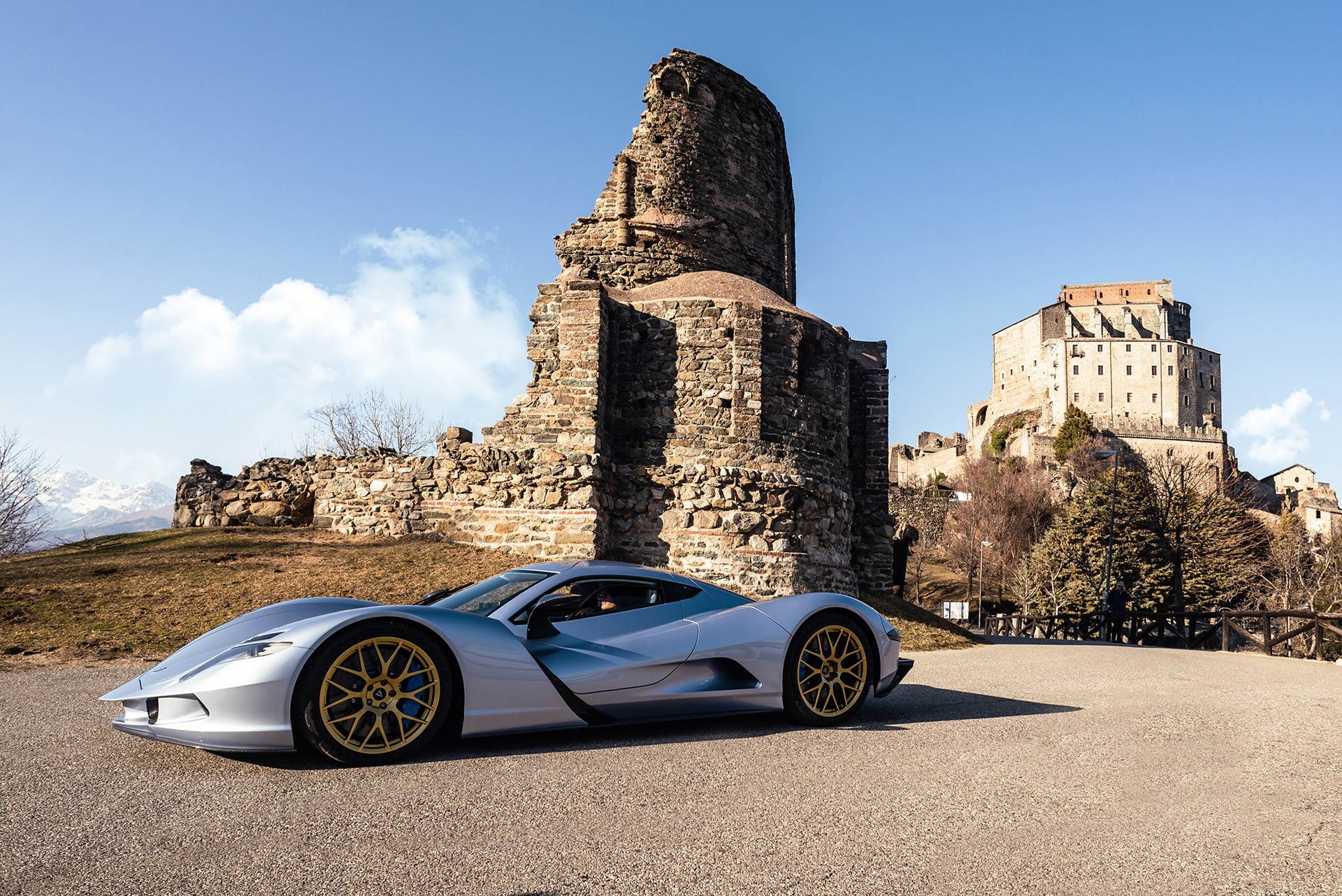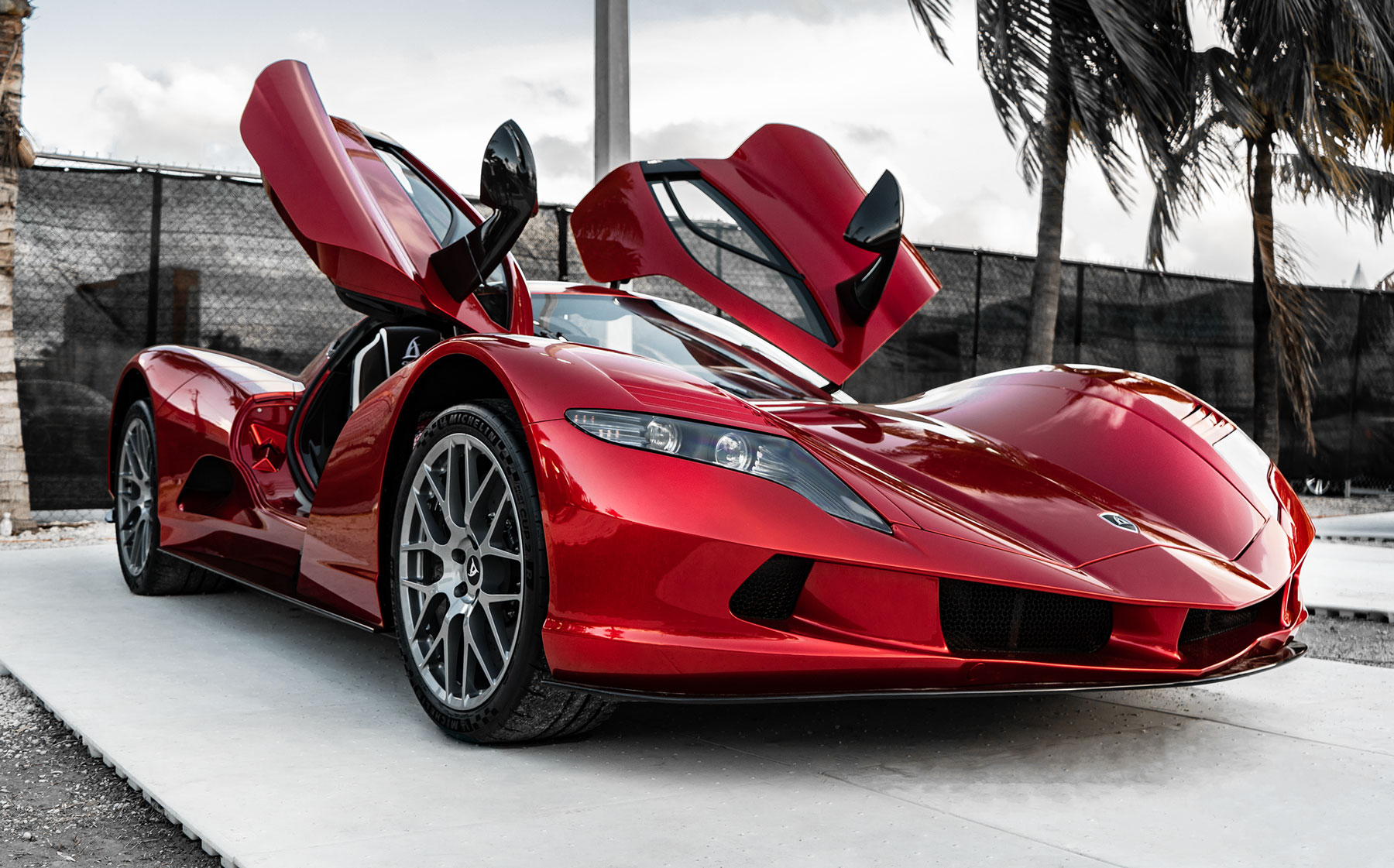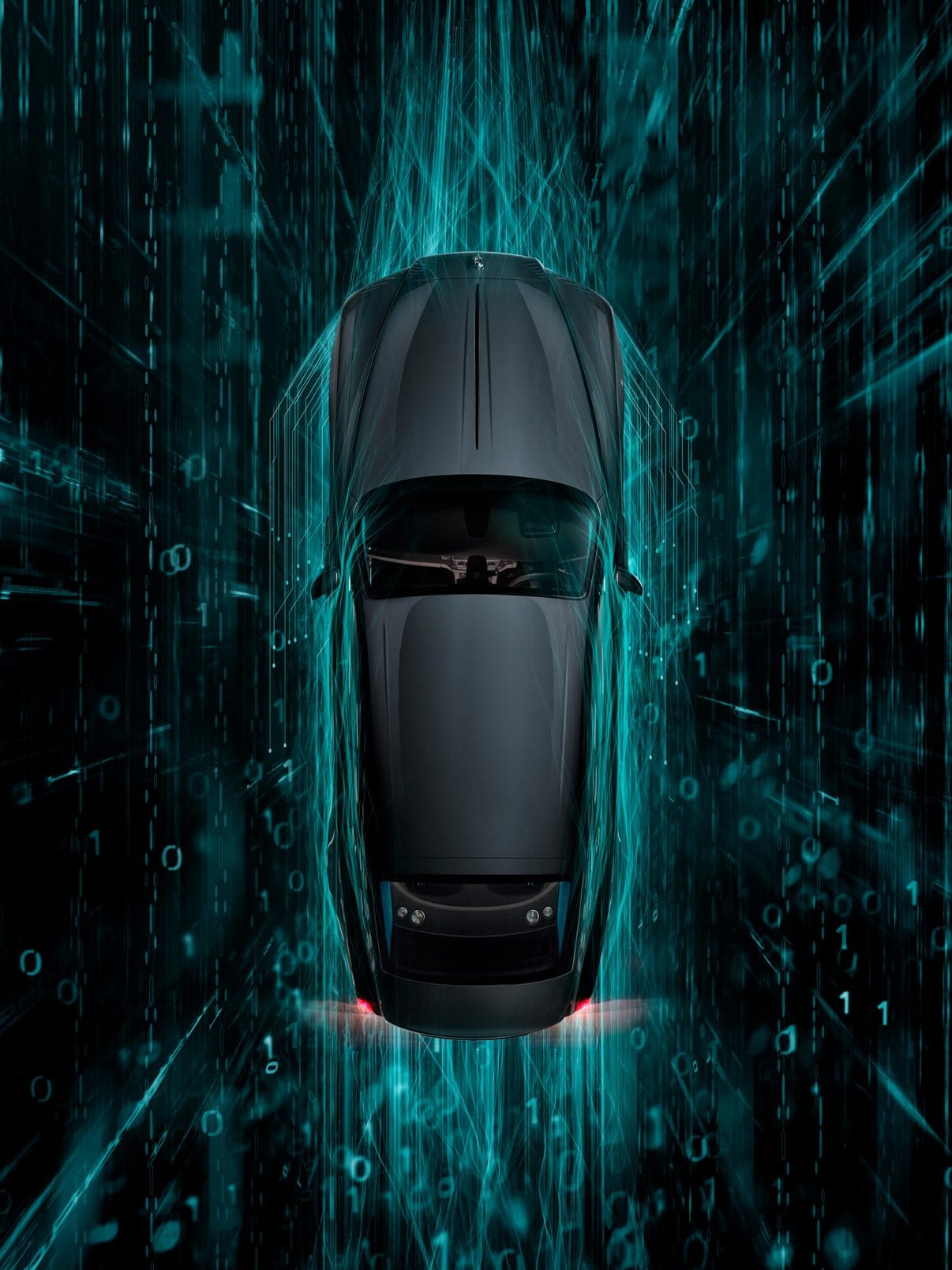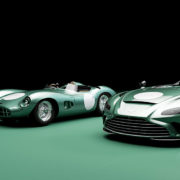Tag Archive for: car
THRILLING NEW OPTIONAL BESPOKE SPECIFICATION REVEALED FOR LIMITED EDITION ASTON MARTIN V12 SPEEDSTER
- Historic DBR1 optional specification offered for visceral open cockpit sports car
- Meticulously crafted details pay homage to 1959 Le Mans winning original
- 88 examples of the Aston Martin V12 Speedster to be built
28 April 2021, Gaydon, UK: Aston Martin is revealing today more details of its forthcoming V12 Speedster – the open cockpit celebration of the British luxury sports car brand’s proud past and exciting future.


The new car aligns gracefully with a heritage that features not only the exceptional DBR1, but also the breathtaking CC100 which was unveiled in 2013 as a stunning celebration of Aston Martin’s century of sports car excellence – reflecting the sporting heritage and exceptional design capability woven throughout well over 100 years of Aston Martin history.

The DBR1 is, to date, the most successful racing machine constructed by Aston Martin, having triumphed in the 1959 staging of both the 24 hours of Le Mans and the 1,000 km of Nürburgring, also winning the latter in 1957 and 1958.
After its debut in 1956 the DBR1 recorded a string of famous victories, including at the Spa Sportscar Race (1957, Tony Brooks); the Goodwood Tourist Trophy (1958, Sir Stirling Moss, Tony Brookes; 1959, Sir Stirling Moss, Carroll Shelby, Jack Fairman); and the 1000 Km at the Nurburgring (1959, Sir Stirling Moss and Jack Fairman) in the same year as that famous Le Mans triumph which culminated in Aston Martin taking the World Sportscar Championship.

Although a car made for competitive racing, the DBR1 was also a precursor for some of the marque’s most well-known heritage ‘DB’ road cars. It was styled in-house by a highly talented designer, Frank Feeley, and, working alongside Chief Racing Designer Ted Cutting, represents what is unquestionably his ‘finest hour’ – indeed the shape of the DBR1 remains one of the most beautiful and graceful of all time.
At the car’s heart from 1958 onwards lay a 2,992 cc straight six engine mated to a David Brown five-speed gearbox. It was capable of powering this c. 800 kg sports car to an estimated top speed in excess of 150 mph.
Produced as a pure racing model – not directly derived from a road car – just five examples of DBR1 were built: four used to such commanding effect by the Aston Martin Works’ team, and a single car for private use.

With such a rich and important history it’s no surprise, then, that the brand should choose to create a dedicated optional DBR1 specification for it’s new V12 Speedster.
Featuring cleverly integrated custom elements reminiscent of the Le Mans winning race car, the Aston Martin V12 Speedster DBR1 specification offers highlights such as the iconic Aston
Martin Racing Green paint finish, Clubsport White pinstripe and roundels, a Satin Silver anodised grille with Clubsport lipstick graphic, Conker saddle leather and Viridian Green technical textile/Caithness leather. All these features hint at the period attributes that made DBR1 the undisputed icon it remains today.
Unique Aston Martin Racing Green driver and passenger helmets sit under transparent ‘windows’, while solid silver ‘wings’ badges glint beneath transparent enamel. The finely judged application of gloss carbon fibre, Caithness Green leather and satin silver brushed aluminium switchgear in the V12 Speedster’s open cabin underline the tasteful homage to a true motoring great.
Satin black diamond turned 21-inch centre lock wheels are a feature of this specialist specification, which each Aston Martin V12 Speedster spending more than 50 hours in the painting process alone at the brand’s advanced paint facility.
Outlining the rationale behind this V12 Speedster tribute specification, Aston Martin Chief Creative Officer, Marek Reichman said: “Emotion and exclusivity are at the heart of this car. A rare and exceptional Aston Martin, It has been engineered to offer a visceral driving experience that belies its elegant, artistic shape.
“Creating a bespoke specification that nods to the glory of the DBR1 has been a huge privilege for my team and I, and I very much look forward to seeing these cars being driven with the same enthusiasm that we have applied to their design.”

At the new car’s heart lies a high-performance variant of Aston Martin’s now iconic, 5.2-litre V12 Twin-Turbo engine, capable of generating an output of around 700 PS and 753 Nm. Offering a compelling breadth of performance, superb response and thrilling V12 soundtrack, the engine is mated to a ZF 8-speed automatic transmission mounted towards the rear of the car.
This translates into a 0-62 mph time in the order of 3.4 seconds and a top speed of 198 mph – no mean feat in a car devoid of roof or windscreen.
Orders are now being taken for the DBR1 custom V12 Speedsters, each being hand built at the company’s Gaydon headquarters, with deliveries expected to begin in mid 2021.
Car manufacturing and engineering – Aspark Company
The first Japanese full-electric hypercar

The production version of the Owl, after its world premiere in Dubai last November, was scheduled to be exhibited at the Geneva International Motor Show.
“After unveiling the Owl at Dubai International Motor Show the company has achieved many progresses on development and production, as well on future strategy as a car manufacturer”, Head Of Sales and Communication Agshin Badalbayli points out.
All major tests related to performance, safety and durability were completed successfully and now the Owl can be seen running on the road.
Meanwhile, the production has been accelerated to deliver the orders on time and the sales and after-sales networks around the world are growing fast.

A second project is coming up
Aspark kicked off a new era in full-electric hypercars with the Owl: but the first project of the Japanese car manufacturer won’t remain alone, as a the development of a second project has already started. Details will be given in the next weeks.

The Power is in our Nature
“The Power is in our Nature” – the official claim of the Owl – perfectly catches the essence of this incredible full-electric hypercar.
Body, chassis and much of the components entirely made by top-level carbon fiber materials, extremely powerful four electric motors, a unique torque vectoring system, an exclusive battery system, and handmade premium interior: the Owl is a compendium of state-of-the-art technology, design and functionality, mixed with a genuine passion for beauty.

The fastest accelerating car in the world: 0-60 mph in 1.69 seconds
The most astonishing performance of the Owl is the acceleration: from 0 to 60 mph in 1.69 seconds*.
The Owl has a unique battery pack for a range of up to 450 km. Top speed is 400 km/h. Furthermore, the Owl has a height of 99 cm: it is probably the lowest road legal electric hypercar in the world.

The world most powerful electric hypercar
The Owl has the most powerful 4 electric motors ever made. They produce a total power of 1480 kW with 2012 horsepower. Overall torque is around 2000 Newton meters.
The Owl has almost three times more power than Formula-E cars and two times more than Formula 1 cars.
The rotation of the motor should be the fastest in the world with 15000 rpm.

Delivered in the second quarter of the year
The production version of the Owl is limited to only 50 cars worldwide. Each one will be fully customizable, each one will be different from the other: exclusivity now has a real meaning.

Production is taking place in Turin, Italy in collaboration with Manifattura Automobili Torino, with the full support of Aspark engineering centres in the world. The first set of the Owl will be delivered by the second quarter of 2020.

Price of the base version is Euro 2,900,000. The Owl can be reserved with a reduced deposit of Euro 50,000.
*One Foot Roll-Out
Running on the road.


Exterior design of the new Mercedes-Maybach S-Class
The new Mercedes-Maybach S-Class: Exterior design
Well-balanced proportions and many exclusive details

The Mercedes-Maybach S-Class expresses the superlative luxury that is the hallmark of the brand. It is a well-conceived combination of sublime beauty and trailblazing technology. It has an 18 centimetre longer wheelbase than the long Mercedes-Benz S-Class. Plus a number of exclusive features.
The Mercedes-Maybach S-Class is a classic three-box saloon with perfect proportions. These are determined by a short front overhang, the longest wheelbase in this model family, a well-balanced rear overhang and large wheels.

Distinguishing features at the front include the distinctive bonnet with a chromed fin and the Mercedes-Maybach radiator grille. This is highly recognisable by its vertical, three-dimensional trim strips. The word mark MAYBACH is elegantly integrated into the chrome surround of the grille. The equally distinctive bumper further emphasises the vehicle’s width with the shape of its air inlets, whose black mesh is also optionally available in chrome.

The Mercedes-Maybach S-Class also differs from its brother models when viewed from the side: The rear doors and flowing, more upright C-pillars underline the model’s superlative status. The fixed quarterlight in the C-pillar is framed by a high-quality surround that seamlessly blends into the side trim. Exclusivity is emphasised by the Maybach brand logo on the C-pillar. In some countries the brand logo is illuminated. The side view is characterised by flush-fitted door handles and 19, 20 or 21-inch wheels specially designed and reserved for this model. The optional ambient illumination projects the brand logo next to the opened front doors in LED technology.

The luxury saloon has the progressively designed, two-section rear lights of the new S-Class generation. Additional lights in the precisely laid-out interior, as well as partly animated functions, also make the Mercedes-Maybach unmistakable at night. The model-specific rear bumper and exhaust tailpipes also lend uniqueness to the rear view.
As well as non-metallic, metallic and designo paint finishes, the range of paintwork for the Mercedes-Maybach additionally includes two-tone finishes with a fine, hand-painted dividing line known as the pin-stripe (see “Under the microscope”). This particularly reinforces the extraordinary hand-built impression.

The new Mercedes-Maybach S-Class: Under the microscope: Two-tone paintwork
One week for the second colour
On request, the exclusive appearance of the Mercedes-Maybach S-Class can be enhanced by a two-tone paint finish with dividing line. This is applied by hand according to the highest quality criteria. It can take up to one week before the vehicle is returned to the regular production process from the custom paintshop.
Even a two-tone Maybach begins its painting process in regular production. In the paintshop, the bodyshell is automatically and electrostatically given a full coat of paint in the colour that will eventually embellish the lower half of the body – plus a layer of clearcoat. In the electrostatic painting process, statically charged paint particles are atomised and deposited on the (earthed) bodyshell.
The bodyshell is then sent to the custom paintshop. Once there, the entire bodyshell is ground to a matt finish by hand. Thorough cleaning is followed by the first, particularly demanding work stage: masking off. As the designers did not position the dividing line between the upper and lower paint finishes in a recess or below a trim strip, this requires extremely precise hand-painting. A special adhesive tape with a corresponding gap is used to apply the only four‑millimetre wide dividing line between the two colours.

As an interesting detail, the doors are weighted with weights before masking the dividing line. This is to simulate the effect of subsequent interior finishing with windows, power window fittings, loudspeakers, panelling and other technical equipment. This allowance ensures that the dividing line along the side and doors will later be at exactly the same height.
All the surfaces that will later bear the lower colour are masked off. These also include the transitions to the interior, e.g. at the doors or wheel arches – even where trim or a lining will later be installed. This too is part of the dedication to quality.
The exposed parts of the body are now completely painted by hand. Pneumatically atomised by compressed air, the paint is applied so that it presents the same picture as after electrostatic painting – this is important because removable parts installed later on, e.g. the bumpers, must precisely match the paint finish. Before the new base coat has fully dried, the masking tape is carefully removed without damaging the edges. The complete bodyshell is then given a new coat of clear varnish.
This has to happen within a very short time window, so that the edges between the paint coats blend into each other and cannot be felt afterwards – unlike competitors, where the dividing line is painted on. If the experts in the custom paintshop are not satisfied, the complete bodyshell is reground, the topcoat is re-finished and the whole bodyshell is given a clearcoat. All in all, the process including the necessary drying times can take up to one week.
The following colour combinations from the Mercedes-Maybach paint chart are available, the choice being dictated by whether the upper colour can fully cover the lower colour:
| Lower colour | Upper colour |
| designo diamond white bright | obsidian black |
| high-tech silver | selenite grey |
| obsidian black | selenite grey |
| nautical blue | high-tech silver |
| rubellite red | designo kalahari gold |
| onyx black | designo kalahari gold |
| obsidian black | high-tech silver |
| obsidian black | rubellite red |
| emerald green | Mojave silver |
| Mojave silver | onyx black |
THE WRAITH KRYPTOS COLLECTION A LABYRINTH OF COMPLEX CIPHERS
Rolls-Royce Collection Cars are poetic embodiments of artistry and skill, envisioned at the hands of the marque’s accomplished designers. They are illustrative of the Bespoke Collective’s mastery of their craft, and extremely limited in number. Incorporating only the finest materials and contemporary applications, Rolls-Royce Collection Cars are executed with creative passion and technical precision. These cars capture clients’ imaginations around the world, joining the chronicles of some of the greatest and most storied Rolls-Royces ever to have been created.

Design is naturally the starting point for these endeavours. For the new Wraith Kryptos Collection, one designer’s passion for cryptography led to Wraith becoming a willing canvas for an intricate and clandestine design. The Wraith Kryptos Collection, which will consist of just 50 motor cars, incorporates a labyrinth of complex ciphers into its beguiling façade.
Rolls-Royce Bespoke Designer, Katrin Lehmann, commented, “The name Kryptos is derived from Ancient Greek, referring to something unseen, hidden and coded, mythical even. Ciphers can be traced through millennia, capturing the imagination of some of the world’s most brilliant minds.

As a designer, I’ve always been fascinated by the notion that you can communicate messages that are understood by only an elite few, using symbols, pictograms, and ciphers. Finding the key becomes integral to appreciating the full meaning of an item that can otherwise be viewed simply as a work of art.”

The Wraith Kryptos Collection carries within it an encrypted cipher that evolves throughout the car for the clients’ pleasure and amusement, leading them on a journey of discovery and intrigue. To the uninitiated, these ciphers appear, on the surface at least, to be an alluring design purely for aesthetic purposes and devoid of any discernible pattern. However, for those that look closer, those few who hold the key, they will embark on an experience that leads to an enlightening conclusion.

Torsten Müller-Ötvös, CEO, Rolls-Royce Motor Cars, commented, “The brilliant and creative minds of our Rolls-Royce Bespoke Collective have excelled once again, creating an extraordinarily contemporary and compelling iteration of Wraith. The Wraith Kryptos Collection, on first glance, is a statement of dynamism. On closer examination, a series of messages are hidden behind a unique Rolls-Royce cipher. I look forward to seeing whether any of our clients will crack the code!”

Indeed, the code is so secret that only two people at the Home of Rolls-Royce in Goodwood know the full resolution of the sequence – the designer and the Chief Executive. The answer has been placed in a sealed envelope, in the safe of the Chief Executive Officer, at the Home of Rolls-Royce, in Goodwood, West Sussex. Clients will be invited to submit their efforts at cracking the code via the members only Rolls-Royce Application, Whispers.
The cryptographic journey begins with the Spirit of Ecstasy, which has graced the bonnet of the marque’s motor cars for over a century. An engraving with green enamel detailing introduces the Rolls-Royce cipher on the base of the enigmatic figurine. Below, recrafted bumper inserts draw the eye lower, subtly modifying both the gesture and posture of Wraith, giving this Collection an identity of its own.

The alluring colourway of the Collection hints at the car’s inner-most secrets. Delphic Grey, a Bespoke exterior hue consisting of a solid Anthracite base colour has a hidden effect – only in sunlight do the blue and green mica flakes appear. This effect is accentuated by a hand-painted double coachline, the upper being painted in the newly developed Kryptos Green while the lower acts as a shadow in Dark Grey, both depicting clues relating to the interior code. Completing the exterior aesthetic are part polished wheels, with Orbit Grey coloured centres featuring a coloured pinstripe.

Inside, stepping over the illuminated treadplates, the cipher evolves deep into the fabric of the motor car. One is immediately greeted by the accented Bespoke Kryptos Green leather hue, which has been developed to incorporate a metallic effect, set against either Selby Grey or Anthracite. In perhaps the most apparent clue, elements of the cipher are embroidered into Wraith’s headrests, where the customary ‘double-R’ emblem can so often be found. For the driver’s enjoyment, an intriguing screen print flows across the metal fascia, spanning the width of the interior.

Enrapturing Wraith’s occupants with light, Wraith Kryptos Collection features a beautifully elaborate, bi-coloured headliner depicting an in-motion data-stream inspired motif. Illuminated door pockets continue this theme with Rolls-Royce woven leather and Kryptos Green threads to reveal an unexpected and subtle illumination that fades towards the base of the pocket. The centre tunnel is exquisitely stitched, repeating the horizontal lines of the door pockets, also hinting towards the driver focused nature of this special motor car.
Rolls-Royce is delighted to unveil this new generation of Collection Car; one that brings with it an intriguing and entertaining challenge, that will be sure to delight. Who will crack the code? And what answers will the code bring? Only time will tell. Or will it?
LEXUS UNVEILS THE WORLD’S FIRST TATTOOED CAR
Using a pure white car as her “canvas” and a Dremel drill tool in place of a fine tattooing needle, Claudia produced a sweeping design featuring koi carp along the entire length of the vehicle. The koi is a motif familiar from traditional Japanese art, representing qualities of good fortune and perseverance.
Lexus has created a short film which goes behind the scenes to reveal how the tattooed car was made. It can be viewed here:
Claudia used the Dremel tool to drill away the surface paint and expose the metal underneath to create the complex pattern, and then applied five litres of high-quality car paint by hand to bring out the details. As a finishing touch, she used gold leaf to create highlights and give the design a stronger 3D effect, before the whole vehicle was given a protective lacquer coating so that it can be driven on the road.

LEXUS UNVEILS THE WORLD’S FIRST TATTOOED CAR
The process took six months to complete from the initial drawings, with the “tattooing” accomplished over five eight-hour days of intensive work. It was physically demanding, with the vibration of the drill and working with an object that, unlike a human customer, couldn’t be moved into a comfortable position as the design progressed. Where any small slips in a human tattoo can quite easily be worked or coloured into the pattern, the “engraving” with the drill required absolute precision.

08-lexus-tattoo-claudiaportrait
The tattooed UX doesn’t have a price tag, but it’s estimated the bespoke work would cost upwards of £120,000.
It was the first time Claudia had applied her skills to metal rather than human skin and she found both similarities and new challenges in the unique commission.

“When you tattoo a person, you have to think about the muscles and tissue beneath the skin. With the car it was about the way the bodywork changes shape over the framework,” said Claudia, who was assisted in her work by her Japanese-born husband Yutaro.

“‘The best thing about tattooing the Lexus UX, and the reason why this car was ideal for the project, is its streamlined shape. Everything from the lines on the side of the body to the shape of the windows, everything is just so dynamic and beautiful. It was a perfect fit for the design and the concept itself,” said Claudia, a co-founder of the Red Point tattoo studio in Islington.

The project stands as a tribute to the takumi craftsmanship that is applied to every Lexus, witnessed in design details and flawless finishes achieved with human skills perfected through years of dedicated training. Similarly, Lexus embraces traditional Japanese aesthetics in its vehicle designs, in elements such as the UX’s washi paper-grain cabin trims and the seamless merging of the interior and exterior through the front screen, echoing the engawa architectural features of Japanese homes.

Luxury News & Magazines - MyLuxePoint is proudly powered by WordPress









